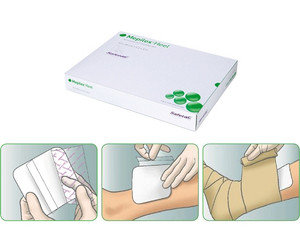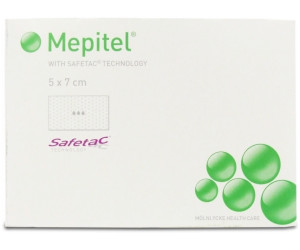
Molnlycke Mepiform Self-adherent soft silicone dressing for scar care
Topical silicone has empirically been shown to have positive impact on hypertrophic scars and keloids. It may take from 3 months up to a year or more to improve an old scar, depending on the condition of the scar tissue. Mepiform shall optimally be worn 24 hours a day. It is recommended that Mepiform is removed once a day, e.g-when showering or bathing, for inspection and washing of the skin. For prophylactic treatment, Mepiform shall be used for 6 months depending on the condition of the scar.
At Selles Medical, we always order such stock in fresh. This can often delay an order by a further 48 hours. It is in the best interest of all customers that we supply the freshest stock that is available featuring the longest expiry dates
Benefits of Mepiform
- Minimises pain and trauma at dressing changes
- No extra fixation is needed
- Mepiform is thin, flexible and discreet
- Can be worn in daily activities
- Can be reapplied
- One Mepiform product can be used for several day
Areas of use
Mepiform is designed for the management of old and new hypertrophic scars, keloids and closed wounds which may prevent the formation of hypertrophic and keloids scars.
How to use
Product description
Mepiform is a thin, discreet and flexible dressing consisting of a laminate (polyurethane and nonwoven) covered with a soft silicone gel.
Safetac technology
Safetac is a patented soft silicone adhesive technology. Dressings with Safetac technology are atraumatic upon removal. These dressings minimise trauma to the wound and the surrounding skin, which minimises pain to the patient. The risk of maceration is minimised by sealing the wound margins.
Intended use
Mepiform is designed for the management of hypertrophic and keloid scars. It can also be used as a prophylactic therapy on closed wounds for prevention of hypertrophic or keloid scarring.
Application
1. Open the packaging and remove the dressing.
2. If necessary, cut to appropriate size allowing overlap of minimum 1cm.
3. When applying Mepiform, make sure the area is dry. When used together with ointment or cream, ensure the dressing covers an area beyond the cream.
4. Remove the release film and apply Mepiform over the scar. Avoid stretching when applying over joints.
Dressing change and removal
1. Mepiform should optimally be worn for 24 hours a day. Remove the dressing once per day for inspection and washing of the skin. The dressing can then be reapplied. Mepiform does not have to be washed/cleansed.
2. Mepiform should under normal conditions be changed every 3 – 7 days or when the adherent properties of the dressing are no longer sufficient.
3. Mepiform is waterproof and can be worn while bathing and showering.
Precautions
Should maceration or rash occur, remove the dressing and allow the skin to recover until the symptom has disappeared, then continue treatment gradually increasing therapy time. If the symptom persists, discontinue use and consult a physician for advice.
Sterility and storage: Sterility is guaranteed unless inner package is damaged or opened prior to use. Do not re-sterilise. Application Clean the wound area. If needed, cut to shape Apply Mepiform to the scar. Re-apply after daily cleaning of the scar.
FAQ
What is Mepiform?
Mepiform is a micro-thin, self-adherent soft silicone dressing for scar care.
How does Mepiform work?
Silicone gel dressings have empirically been shown to have positive impact on red and raised scars (hypertrophic scars and keloids). However, the mechanism of action for silicone on scars is not yet completely understood. Mepiform is designed to flatten, soften and fade red and raised scars, thus making them less visible
For which types of scars can I use Mepiform?
Mepiform is ideal for the treatment of both old and new scars that are red and raised. Mepiform can also be used on newly healed closed wounds to prevent the formation of red and raised scars.
What kind of scars is not suitable for treatment?
Mepiform has no effect on old, flat, white scars.
How long time does it take before I see any result?
The length of treatment time will differ from person to person and depends on the condition and the age of the scar. First results may be seen already after 2 months, however the improvement of the scar may continue for up to a year under treatment.
As a preventative treatment Mepiform may be used for at least 1 month. The effectiveness of the treatment is dependent on the wearing time. Mepiform is designed to be worn 24 hours per day for optimum results. Since Mepiform is thin, comfortable and conforms well to body contours it can be worn during most daily activities.
Will my scar dissapear completely?
Mepiform can soften, fade and flatten your scar and improve the appearance of your skin. However, some evidence of the scar may remain.
Can Mepiform be used on children?
Yes, when used as directed it is safe to use on children
How soon can Mepiform be used after an injury?
Mepiform can be used as soon as the wound is completely closed. Do not use on open, infected wounds or over scabs.
If my scar is bigger than the dressing, may I join pieces together?
You can use more than one dressing and join pieces together edge to edge. You can also cut the dressing to the size and form desired.
What is Mepiform made of?
Mepiform consists of a polyurethane and viscose non-woven laminate covered with a soft silicone gel.
Will Mepiform prevent scarring?
Mepiform can be used on newly healed closed wounds to prevent the formation of red and raised scars.
Is there clinical evidence that Mepiform works?
There are several clinical studies confirming that Mepiform works, please see Reference list.
Should Mepiform be cleaned?
No. Mepiform does not have to be cleaned. Mepiform should be changed when the dressing no longer sticks in place, which generally occurs after 3-7 days usage, depending on the location of the scar area.
Is there any consensus among professionals in scar treatment?
There is a consensus for silicone gel sheeting in scar management by an international group of professionals scar experts; International Clinical Recommendations on Scar Management. Mustoe TA et al. Plast. Reconstr. Surg. 2002 Vol. 110, No 2, 560-571.





